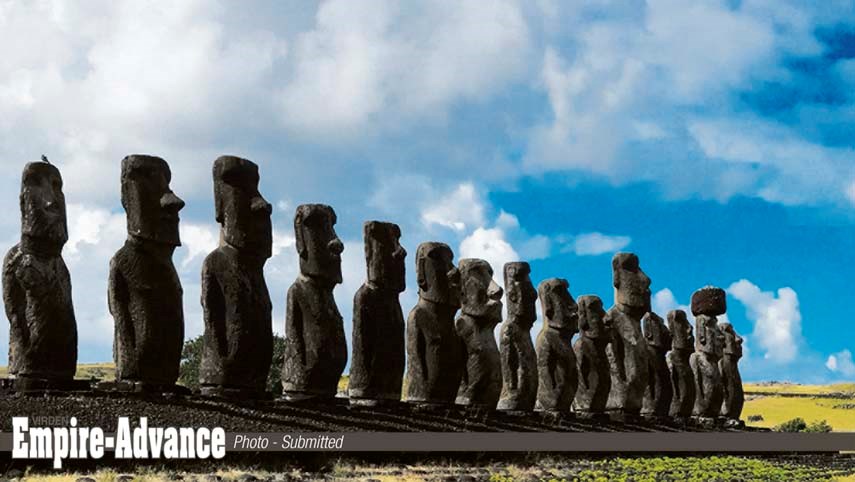We board a plane in Santiago, Chili for a 2,300 mile, five-hour flight across the South Pacific Ocean to the tiny island. Arriving at the only town on the island, Hanga Roa, we were immediately in love with the relaxed atmosphere and welcoming greetings of the local Rapa Nui people. Lovely, fragrant fresh tropical flower leis were draped on our necks, the air is soft, palm trees are waving in the breeze. Holy Cow we did not expect this, being part of Chili we sort of expected more of the same, but it is truly a Polynesian paradise.
Easter Island is the most remote, isolated, habituated island in the world. From high in the sky this 14 mile by 7 mile island looks like a small speck of green in a vast ocean of blue. It is an ancient volcanic rock in the middle of thousands of miles of water. The land is, for the most part, soft edge rolling hills covered in lush green grass.
There are just over eight thousand people here, and nearly that many wild horses as well. The horses roam free, no fear of humans or cars; kids ride free in the back of pickup trucks, hair flowing in the breeze, there are no traffic lights; fishermen sell their catch on the street corners. The scent of tropical fruit and flowers flows all around us as we walk the streets to the beach to watch the surfers play in the waves. Our first day is all about exploring on foot, the small town and the trail of Moai stone statues along the shore. Sunset is a treat with half a dozen Moai heads in our line of vision.
Fishing, farming, and tourism make up the bulk of the economy here. People are happy, relaxed, friendly, and crime is rare. Locals prefer the traditional name of Rapa Nui for their island home; it was changed in 1722 when a long ago Dutch explorer came upon the island on Easter Sunday. In the 1700s and 1800s the island population of 20 thousand was decimated by slave traders, war, small pox and tuberculosis. All foreigners evacuated and the population plummeted to 110 souls. They have rebounded to about 4,000 natives and at least that many Chileans who now call this island home.
For the next three days we crisscross this wonderful island on excursions that led us along sandy coastal trails and small paved roads. There are over 900 Moai statues, some an impressive sight of 15 giants all lined up in a row, some laying face down and all alone miles from anywhere nearly buried in the reddish soil. Moai dot the shores of the entire island, many lay flat as they were interrupted on their journey to be erected.
One morning as the stars shone in a chilly darkness, we get up early for sunrise at Ahu Tongariki, a truly impressive sight of 15 Moai waiting in the darkness. As the day brightens we are treated to a glorious sunrise and a feeling of special spiritual calm. From here, we can also see the quarry where these huge stone men were created. On another wonderful tropical morning we visit the quarry to see at least 30 or 40 stone heads anchored in the surrounding hillsides.
Some have been excavated to reveal at least 60% of the original body is still buried underground. It is fascinating to wander among these giants and wonder at the artistry and tenacity it must have taken to build and move these stone giants in an age when the only tools were stone chisels and stone hammers. Most of the Moai are over 15 feet high and weigh 14 tonnes. The largest is 33 feet high weighing over 80 tonnes! Built between 1400 and 1650 they are a massive undertaking to carve let alone move for up to 11 miles. How was it done? Speculation abounds. No one knows for sure. What we do know is they are fascinating to see, huge blocks of carved stone, some with seashell eyes and deep black obsidian (hard, shiny, glass like stone) pupils.
We fly away wishing we had more than just four short days, it has been such a delightful time. For anyone going, try to spend at least a week to truly absorb the culture and beauty of this remote Polynesian island. It is absolutely worth the time and trouble to get here.
There is a lovely beach at Anakena with white sand, coconut palms and seven silent giant Moai to watch over you. The water is warm, turtles swim right past you. Surfing is great and you are sure to see many wild horses along the roads or grazing in the town limits too. Best of all are the welcoming people, beautiful culture and great seafood. Can’t wait to return…




